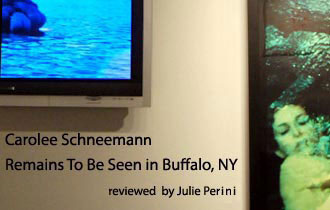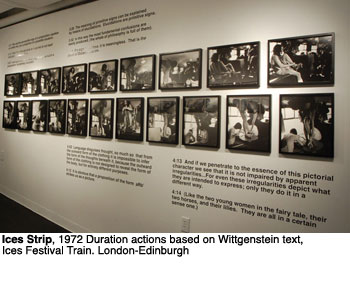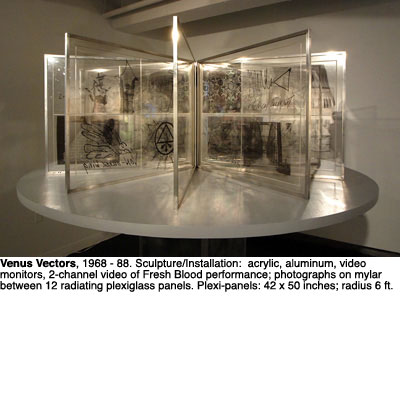Review: Carolee Schneemann at CEPA, Buffalo, NY
05.05.07
 Carolee Schneemann: Remains To Be Seen at CEPA, Buffalo, NY
Carolee Schneemann: Remains To Be Seen at CEPA, Buffalo, NY
Decades before The Vagina Monologues made talking cunts a bit more acceptable to the general public, Carolee Schneemann gave voice to her own vagina by unraveling from it a long scroll of paper and reading its contents aloud. Schneemann’s Interior Scroll (1975) has become one of the iconographic performances from the 1960s and 1970s. The documentation from this action shows the artist naked, splattered with paint, her feet planted firmly in a warrior pose as she reads comments made about her work by one of her filmmaking contemporaries:
“…you are charming
but don’t ask us
to look at your films
we cannot
there are certain films
we cannot look at
the personal clutter
the persistence of feelings
the hand-touch sensibility
the diaristic indulgence…”
Despite such bald derision and condescension, it is fortunate for us that Carolee Schneemann shook off one bad review and continued to produce artwork. She has remained a major figure in contemporary art for more than forty years, creating work that keeps one finger on the pulse of humanity, addressing the brutal reality of war, and another finger on the collective clitoris, emphasizing female agency and embodiment.
 CEPA Gallery’s Remains To Be Seen is a comprehensive survey of the output of this multi-disciplinary artist whose work is on view now through May 26 in Buffalo, NY. First-time viewers of her work will have the opportunity to experience something akin to the initial physical jolt felt by viewers of some of her more shocking early works, including documentation and artifacts from Interior Scroll. But all visitors to the exhibition will discover that there is much more to the work of Carolee Schneemann, a pioneering feminist artist whose body-based practice includes work in painting, collage, photography, film, performance, video, as well as live events that utilize user-activated technological components. Fusing socio-political content with formal experimentation is a hallmark of Schneeman’s work, and this ambitious exhibition, only the second retrospective of her work yet mounted, provides a critical and timely look at the work of this seminal artist.
CEPA Gallery’s Remains To Be Seen is a comprehensive survey of the output of this multi-disciplinary artist whose work is on view now through May 26 in Buffalo, NY. First-time viewers of her work will have the opportunity to experience something akin to the initial physical jolt felt by viewers of some of her more shocking early works, including documentation and artifacts from Interior Scroll. But all visitors to the exhibition will discover that there is much more to the work of Carolee Schneemann, a pioneering feminist artist whose body-based practice includes work in painting, collage, photography, film, performance, video, as well as live events that utilize user-activated technological components. Fusing socio-political content with formal experimentation is a hallmark of Schneeman’s work, and this ambitious exhibition, only the second retrospective of her work yet mounted, provides a critical and timely look at the work of this seminal artist.
CEPA Gallery presents Remains To Be Seen in conjunction with Breaking Borders, an exhibition at the Museum of Contemporary Canadian Art in Toronto, Canada, featuring recent multi-media works that Schneemann produced and/or exhibited in Canada. It is fitting that this show straddles the U.S. and Canadian border, as Schneemann’s work has always been about transgressing borders and encouraging exchange. These two institutions are participating in the current wave of exhibitions, conferences, and publications examining the legacy of the Feminist Art Movement and recent attitudes toward feminism, gender, sexuality, and culture. Such exhibitions currently on view include “WACK! Art and the Feminist Revolution” at the Los Angeles Museum of Contemporary Art and the Brooklyn Museum’s “Global Feminisms.”
 Remains To Be Seen challenges the idea that retrospective exhibitions must present an ordered, chronological sequence of work demonstrating an artist’s progress. Instead, the work is arranged thematically, grouped into three physical and conceptual areas: Erotics, War, and Felines. Not surprisingly, the basement gallery houses the work on Erotics. In order to access this work, visitors must navigate through the bowels of Buffalo’s Market Arcade. The intimacy and privacy the basement gallery provides is well suited for meditation on the collection of works that explores relationships to the body – to one’s own body, to the body of a lover, to the body as mediated through photographic representation, and to the human body in nature. The other gallery spaces are more public and exposed. The work on War occupies the main floor gallery with pieces that address 9/11, Iraq, Palenstine, Vietnam, and Kosovo. The top floor contains pieces that explore the relationship between the artist and her cats. The most public venue of all, the windows on Main Street, showcase Vesper’s Pool (1999), a mixed media work about the death of one of Schneemann’s cats.
Remains To Be Seen challenges the idea that retrospective exhibitions must present an ordered, chronological sequence of work demonstrating an artist’s progress. Instead, the work is arranged thematically, grouped into three physical and conceptual areas: Erotics, War, and Felines. Not surprisingly, the basement gallery houses the work on Erotics. In order to access this work, visitors must navigate through the bowels of Buffalo’s Market Arcade. The intimacy and privacy the basement gallery provides is well suited for meditation on the collection of works that explores relationships to the body – to one’s own body, to the body of a lover, to the body as mediated through photographic representation, and to the human body in nature. The other gallery spaces are more public and exposed. The work on War occupies the main floor gallery with pieces that address 9/11, Iraq, Palenstine, Vietnam, and Kosovo. The top floor contains pieces that explore the relationship between the artist and her cats. The most public venue of all, the windows on Main Street, showcase Vesper’s Pool (1999), a mixed media work about the death of one of Schneemann’s cats.
One of the significant contributions of this show is the way it highlights and tackles the question of how to re-present what was once present and embodied. Schneemann herself has revisited several of her seminal performances pieces over the years, reworking them into new visual layouts such as photomontages and multi-media installation. To look at documentation of performance art from the 1960s and 1970s is to glimpse moments from an era during which the art world seems to have been pulsating with energy, nudity, sex, danger, violence, pleasure, and protest. These early experimenters used their own bodies as material for their artwork – their flesh became canvases to be inscribed and used in what Schneemann called “Kinetic Theater,” her version of the Happening.
 Documentation from several of Schneemann’s well-known performances is on view, including film documentation of Meat Joy (1964), here presented on DVD. Meat Joy involved several unclad performers on stage, writhing around with one another, various raw meats such as fish, chicken, and sausage, wet paint, plastic, rope, brushes, and paper scraps. In an essay collected in the 1967 book Theatre Experiment, Schnemann said of this early work, “The intention of Meat Joy, like all these images, was the visual transformation of the naked body-as-environment.” Interior Scroll’s strategy for its re-presentation in the gallery consists of a piece of the actual scroll on view under glass and hung on a wall so that the scroll unfurls like a strip of film. Alongside the object is a series of black and white photographs of the event, also displayed like a filmstrip with each descending image depicting later moments in the performance.
Documentation from several of Schneemann’s well-known performances is on view, including film documentation of Meat Joy (1964), here presented on DVD. Meat Joy involved several unclad performers on stage, writhing around with one another, various raw meats such as fish, chicken, and sausage, wet paint, plastic, rope, brushes, and paper scraps. In an essay collected in the 1967 book Theatre Experiment, Schnemann said of this early work, “The intention of Meat Joy, like all these images, was the visual transformation of the naked body-as-environment.” Interior Scroll’s strategy for its re-presentation in the gallery consists of a piece of the actual scroll on view under glass and hung on a wall so that the scroll unfurls like a strip of film. Alongside the object is a series of black and white photographs of the event, also displayed like a filmstrip with each descending image depicting later moments in the performance.
Similar to the serial photographs of Interior Scroll, Ices Strip (1975) consists of photographs of Schneemann undressing and redressing as she prepares to roller skate the length of the Ices Festival Train hurtling 133 kilometers per hour from London to Edinburgh. Water Lake, Water Needle (1966) uses large color photographs alongside video documentation of the event that involved several performers enacting aerial Kinetic Theater as they traversed ropes strung through trees and across Lake Mahwah in New Jersey.
 Snows (1967) was a performance that came out of the same time period as Water Lake, Water Needle, and is here shown as a photogrid of performance and film still including images from the Vietnam War. This work was a performed as part of an event in New York City called “Angry Arts/Artists against the Vietnam War” and in her book, Imaging Her Erotics, she writes of the work, “Violence is not always destructive. Destructiveness is essential to creation. Snow’s imagery is, finally, ambiguous.” Not captured by the photogrid display is the revolving light sculpture that had hung above the performers, the contact microphones placed under theater seats, the films projected, and the sounds that pulsed through large speakers. Schneemann is less known for her work with motorized and computerized elements. Her experiments with new technologies are worth noting as her more visceral body-based work often overshadows her technical work in art historical literature. War Mop (1983) brings together feminist concerns, concerns with global conflict, and an interest in mechanization and media. This kinetic sculpture consists of a motorized mop that rhythmically thumps the top of a television monitor displaying images of the war in Lebanon. Its playfulness is offset by its serious content and expression of frustration.
Snows (1967) was a performance that came out of the same time period as Water Lake, Water Needle, and is here shown as a photogrid of performance and film still including images from the Vietnam War. This work was a performed as part of an event in New York City called “Angry Arts/Artists against the Vietnam War” and in her book, Imaging Her Erotics, she writes of the work, “Violence is not always destructive. Destructiveness is essential to creation. Snow’s imagery is, finally, ambiguous.” Not captured by the photogrid display is the revolving light sculpture that had hung above the performers, the contact microphones placed under theater seats, the films projected, and the sounds that pulsed through large speakers. Schneemann is less known for her work with motorized and computerized elements. Her experiments with new technologies are worth noting as her more visceral body-based work often overshadows her technical work in art historical literature. War Mop (1983) brings together feminist concerns, concerns with global conflict, and an interest in mechanization and media. This kinetic sculpture consists of a motorized mop that rhythmically thumps the top of a television monitor displaying images of the war in Lebanon. Its playfulness is offset by its serious content and expression of frustration.
Remains To Be Seen presents two pieces that have never been exhibited elsewhere. Aggression for Couples (1972) and Exercise for Couples (1972) are series of photographs, or what Schneemann calls “comic strips.” The former work shows the artist and Anthony McCall in a domestic interior; he sits in an armchair reading a newspaper while she approaches him and they begin to wrestle on the chair and floor. The latter presents a study of the movement of these same two bodies, less antagonistic but no less erotic than the others.
 While most of the pieces fall into the “not-to-be-missed” category, the 16mm films Fuses and Viet-Flakes, both from 1965, deserve particular mention. Fuses is a landmark avant-garde film, documenting several years of lovemaking between the artist and her then partner James Tenney. The film has been repeatedly banned and censored for its explicit genital heterosexuality, while at the same time it has been lauded for its lyric, energetic beauty. Viet-Flakes is a meditation on the war in Vietnam, bombarding viewers with images of the horrors of war while seducing them with a soundtrack (by James Tenney) that collages popular tunes like the Beatle’s “We Can Work it Out” with Vietnamese folk songs.
While most of the pieces fall into the “not-to-be-missed” category, the 16mm films Fuses and Viet-Flakes, both from 1965, deserve particular mention. Fuses is a landmark avant-garde film, documenting several years of lovemaking between the artist and her then partner James Tenney. The film has been repeatedly banned and censored for its explicit genital heterosexuality, while at the same time it has been lauded for its lyric, energetic beauty. Viet-Flakes is a meditation on the war in Vietnam, bombarding viewers with images of the horrors of war while seducing them with a soundtrack (by James Tenney) that collages popular tunes like the Beatle’s “We Can Work it Out” with Vietnamese folk songs.
The work is strong and the curatorial decisions provide a useful framework for both veteran and virgin viewers of Schneemann’s work. A few pieces, including the documentation of Meat Joy and the collages Oil Paths to Kosovo (1999) and Dead Engineer – Kosovo (1999) seem misplaced, as they are included in the top floor gallery with the work on Felines. Visitors unaware of this tri-part thematic might not notice such misplaced elements, as there is no signage identifying the various spaces of the gallery as housing work that fits the particular themes. This small addition to the show might have made the curatorial choices more clear, particularly for a casual visitor to the exhibition.
Remains To Be Seen provides an intense experience of Schneemann’s work, presenting seminal works alongside lesser-known pieces, demonstrating the breadth and depth of her socially engaged yet highly personal practice. To commemorate this effort, CEPA Gallery and the Museum of Contemporary Canadian Art jointly produced a catalogue, Split Decision, that contains full-color illustrations of the works included in the shows, and contextualizing essays by Canadian curator Jim Drobnick, Buffalo media artist Caroline Koebel, and independent scholar and critic Thomas McEvilley. The book is a worthy addition to any library on contemporary art.
See Remains To Be Seen at CEPA in Buffalo, NY through May 26, 2007